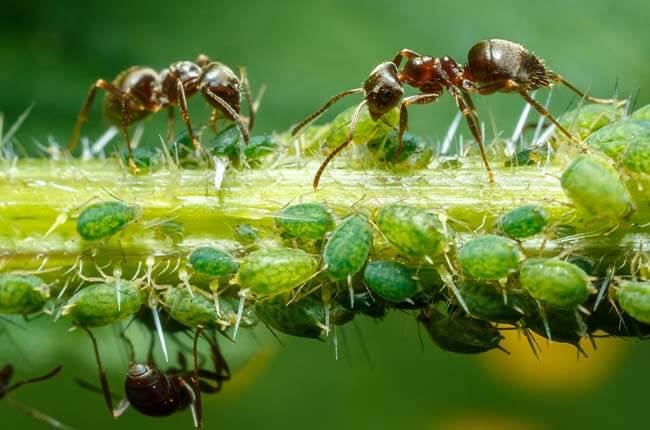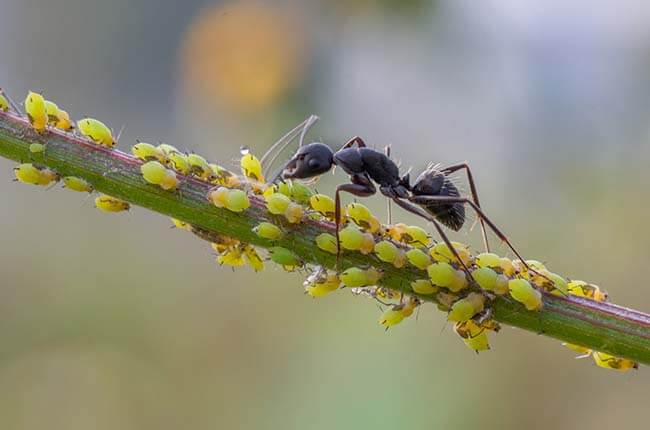All of a sudden ants can appear in your garden out of nowhere. They can be making homes in the soil around your potted plants or veggies and flowers in the raised beds.
Should you be worried about ants in the garden?
Ants in the garden should be removed because they bring with them pests such as sap-sucking aphids that feed on plants. They can carry away seeds planted in the garden and can stunt plant growth by loosening too much of the soil around the root ball. Certain species of ants, especially fire ants, also cause a painful sting.
In this article, I will explain how ants can wreak havoc in your garden and the effective ways to remove them without killing your plants.
Let’s get started.
1. Why do ants appear in the garden?
The main reason why ants appear in the garden is that they are looking for food.
For food, most ants prefer sweet foods, but some species such as Argentine ants also eat live and dead insects, meat, and damaged fruit.
The seeds, seedlings, and fruits are rich sources of sugar for ants. Most importantly, they work together with insects such as aphids on plants that produce a sugary liquid for them.
Depending on the species of ants, they are the most active in spring and summer. They do not venture above ground in freezing conditions.
They also thrive in environments that are humid and experience higher amounts of rainfall.
Another reason why ants appear in the soil in potted plants or in the garden is that it protects them from the wind, the cold, and predators.
2. Should I remove ants in my garden?
If a colony of ants makes themselves home in your garden, they definitely need to be removed.
The first reason is that ants burrow and make many tunnels in the soil. This can create too much space around the root balls of the plants and would cause water to pass through the soil too quickly. The roots of the plants would then not have enough time to absorb the water they need. When the problem is serious enough, your plant will turn yellow or even wilt, although this can occur due to nutrient deficiency, underwatering or overwatering.
Another problem with ants is that they often bring pests such as aphids, which are tiny soft-bodied insects of green or brown color, to the plants. Ants do that because aphids suck on plant leaves or stems and excrete a sweet sugary liquid that ants feed on. The relationship between ants and aphids is symbiotic or mutually beneficial as aphids provide food for ants in exchange for ants’ protection against predators.
Where there is a large infestation of aphids on plants, the ant numbers can begin to get out of control.

Also, ants can carry away your seeds planted in the garden and bring them to their nest. They can even eat your plants and seedlings and affect germination.
Some species of ants are major pests. They include:
- Argentine ant
- Carpenter ant
- Fire ant
- Pharaoh’s ant
- Sugar ant
- Thief ant
- Harvester ant
- Black house ant
- Odorous house ant
The black-colored Carpenter ants, for example, are a major pest in agriculture as they can hollow out sections of a tree.
The copper-colored Fire ants are also agricultural pests and can attack with a painful sting which can result in a sore pimple some 48 hours later.
Finally, ants can invade your home when it rains or when they discover some food they particularly like. It’s common to find large numbers of ants feeding on left-out cat food, and dog food. They can also make their way into the pantry and begin to congregate around sweet foods such as cookies, and sugar. The “common ant” is often found at home scavenging in the kitchen and garbage, thus spreading diseases such as salmonella.
3. How to find ant nests in the garden?
The nests of ants in the garden can often be identified by a mound of soil with a hole at the top, serving as the entrance for the ant nest which can go several feet underground.
Ant mounds are usually a few inches (6-8 cm) tall, but some ant hills can be gigantic or up to 15 inches (40 cm) tall.
If you cannot find an ant nest, follow the trail of ants and see where they are headed to. They are often out in warm weather.
You can also inspect under objects on the ground, such as a rotten logs.
4. How to get rid of ants without killing my plants?
4.1 Cold or hot water
The cold water method is the most humane, and most effective to get rid of the ants and it does not kill the plants nearby. For this method to be effective, the ant nests need to be identified first.
Shave off the top of the anthill to expose the nest underneath. Use a water hose to flood the anthills. Ants will leave when their tunnels are flooded and they cannot breathe.
If there are no plants nearby and there is no danger of scorching plants, you may pour a kettle of boiling water on the entrance to an ant mound.
4.2 Diatomaceous earth
Diatomaceous earth is also an effective non-toxic way to kill ants by dehydrating them. Spread it around their nest. It will take a couple of days to see it work.

Diatomaceous Earth (organic)
4.3 Peppermint
Ants hate peppermint. You can plant some peppermint plants in your garden, or soak some peppermint oil in a cotton ball and leave them in areas where you don’t want the ants to go. Also, you can spread cinnamon powder around their nest and they will quickly vacate the area.
4.4 Vinegar
Mix up a mix of 50/50 vinegar or water and spray it directly on the ants. They will die. But, the smell of vinegar can linger for a few days.
4.5 Citric juice
The strong acid in lemon juice can ward them off. You need a lot of lemon juice though. Make a mixture of 30% lemon juice and 70% water. Then spray it on the entrance of an ant mound, and anywhere you see ants.
4.6 Borax and sugar
Make a thick paste using 1 tablespoon of borax with 2 tablespoons of sugar and 1 tablespoon of water. Sugar is used as bait and boric acid can kill ants.
Don’t make the paste too runny. The idea is not to kill the ants on the spot, but to get them to carry the borax back and kill everything in the nest over a day or two.
Put the paste in a small plastic container or a bottle pierced with some holes for ants to enter. Place it near the entrance of an ant nest so that other animals like cats will not get to it.
4.7 Chemical pesticide
The advantage of using ant baits is that they will be taken by the ants back to the colony and this is an effective method if you haven’t been able to find where the colony of ants lives.
But this should be the last resort because ant baits contain a range of chemical pesticides. Those on the market generally contain:
- Boric acid or other borates
- Hydramethylnon
- Neonicotinoids
- Fenoxycarb
These chemicals are moderately toxic to humans, and therefore you shouldn’t use them if you have a vegetable garden. The toxins can get absorbed into the plants and make you ill if you eat vegetables and fruits from your garden.
5. What would happen if I leave the ants alone?
Left to its own devices an ant colony will grow as large as it can.
An ant queen can normally lay up to 1500 eggs per day. For harvester ants, their colonies have been documented to live as long as 17 years.
Conclusion
Ants in the garden should be removed as soon as possible before they colonize your raised beds and wreak havoc on your plants.
The most important is to identify the source or the home of ants. If the problem is not serious, it is best to start with natural ways such as flooding the ant mounds with water, and putting peppermint, cinnamon, or vinegar near their nests, before using methods that involve chemicals such as borax or pesticides.
Happy gardening!
References
Mcintyma. (2020). Ants. Oregon State University.
Stocum, Q. (2019). Ants: Friend or Foe?. Pennsylvania State University
Durairaj, A. E. (2021). How to Kill and Repel Ants Safely
Pesticide Research Institute. (2015). Indoor Ant Control
Western Exterminator Company. Common Ant Species.
- 5 Ways To Break Seed Dormancy: Which is the Best? - May 22, 2022
- Ants in Garden: 7 Ways to Remove Them (Naturally) - April 23, 2022
- Top 19 Plants with Aerial Roots (With Pictures) - April 17, 2022

